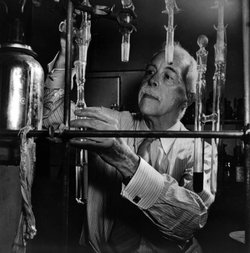Gilbert N. Lewis
|
|
Gilbert Newton Lewis (October 23, 1875-March 23, 1946) was a famous physical chemist.
Early life
Lewis was born in Weymouth, Massachusetts as the son of a Dartmouth-graduated lawyer/broker. He was a precocious child who learned to read at age three.
His family moved to Lincoln, Nebraska when he was 9. He was homeschooled until age 9. He went to public school from age 9 to 14 and then he went to the University of Nebraska, and three years later transferred to the Harvard University where he showed an interest in economics, but concentrated in chemistry, getting his B.A. in 1896 and his Ph.D. in 1899. His first published work, a study of thermochemical and electrochemical properties of amalgams, was based on his doctoral research and was published in 1898.
Career
After earning his Ph.D., he stayed as an instructor for a year before taking a traveling fellowship, studying under the physical chemist Wilhelm Ostwald at Leipzig and Walter Nernst at Göttingen. He then returned to Harvard as an instructor for three more years, and in 1904 left to become superintendent of weights and measures for the Bureau of Science of the Philippine Islands in Manila. The next year he returned to Cambridge when the Massachusetts Institute of Technology (MIT) appointed him to a faculty position, in which he had a chance to join a group of outstanding physical chemists under the direction of Arthur Amos Noyes. He quickly rose in rank, becoming assistant professor in 1907, associate professor on 1908, and full professor in 1911. He left MIT to become professor of physical chemistry and dean of the College of Chemistry at the University of California, Berkeley in 1912.
In 1908 he published the first of several papers on relativity, in which he derived the mass-energy relationship in a different way from Albert Einstein's derivation.
On June 21, 1912, he married Mary Hinckley Sheldon, daughter of a Harvard professor of Romance languages. They had two sons, both of whom became chemistry professors, and a daughter.
In 1913, he was elected to the National Academy of Sciences, but in 1934 he resigned in a dispute over the internal politics of that institution.
In 1916, he formulated the idea that a covalent bond consisted of a shared pair of electrons and defined the term odd molecule when an electron is not shared. His ideas on chemical bonding were expanded upon by Irving Langmuir and became the inspiration for the studies on the nature of the chemical bond by Linus Pauling.
In 1919, by studying the magnetic properties of solutions of oxygen in liquid nitrogen, he found that O4 molecules were formed. This was the first evidence for tetratomic oxygen.
In 1923, he formulated the electron-pair theory of acid-base reactions. In the so-called Lewis theory of acids and bases, a "Lewis acid" is an electron-pair acceptor and a "Lewis base" is an electron-pair donor.
Students of chemistry learn about a notation system for the valence electrons which is known as the Lewis dot structure.
Based on work by J. Willard Gibbs, it was known that chemical reactions proceeded to an equilibrium determined by the free energy of the substances taking part. Lewis spent 25 years determining free energies of various substances. In 1923 he and Merle Randall published the results of this study and formalizing chemical thermodynamics.
In 1926, he coined the term "photon" for the smallest unit of radiant energy.
Lewis was the first to produce a pure sample of deuterium oxide (heavy water) in 1933. By accelerating deuterons (deuterium nuclei) in Ernest O. Lawrence's cyclotron, he was able to study many of the properties of atomic nuclei.
In the last years of his life, he established that phosphorescence of organic molecules involves an excited triplet state (a state in which electrons that would normally be paired with opposite spins are instead excited to have their spin vectors in the same direction) and measured the magnetic properties of this triplet state.
During his career he published on many other subjects besides those mentioned in this article, ranging from the nature of light quanta to the economics of price stabilization.
He died at age 70 of a heart attack while working in his laboratory in Berkeley.
de:Gilbert Newton Lewis fr:Gilbert Newton Lewis it:Gilbert Lewis ja:ギルバート・ルイス nl:Gilbert Lewis nn:Gilbert Newton Lewis ru:Льюис, Гилберт Ньютон

